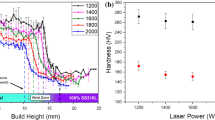Abstract
A range of engineering alloys was selected to create two distinct sets of structures. One was functionally graded materials (FGM)—using pairs of these alloys—and the second type was a series of wafer-layered structures using pairs of these alloys in different combinations. The aim of this investigation was to identify unique sets of structures of alloys which provide very different coefficients of thermal expansion (CTE) compared to those of individual elements. The process used to create these structures was laser direct metal deposition (DMD) additive manufacturing technology. The linear thermal expansion coefficients of these samples were measured and the results show that specific sets of FGM and wafer type structures of specific constituent metal alloys can be fabricated by DMD, in which the overall coefficient of thermal expansion of these new structures is significantly different from that of each alloy when measured individually. FGM and wafer type structures of specific constituent metal alloys have lower CTE than those of original alloys.
Similar content being viewed by others
References
Ruys A and Sun D (2002) Functionally Graded Materials (FGM) and Their Production Methods. URL: http://www.azom.com/article.aspx?ArticleID=1592
Zhang J, Wang Y-Q, Zhou B-L, Wu X-Q (1998) Functionally graded Al/Mg2Si in-situ composites prepared by centrifugal casting. J Mater Sci Lett 17:1677–1679
Jedamzik R, Neubrand A, Rodel J (2000) Production of functionally graded materials from electrochemically modified carbon preforms. J Am Ceram Soc 83(4):983–985
Kalaitzidou K, Athreya S, Chun C, Das GWS (2009) Laser sintering Vs melt compounding: a new approach for functionally graded polymer nanocomposites. Proceedings of ICCM-17 17th International Conference on Composite Materials
Miyamoto Y, Kaysser WA, Rabin BH, Kawasaki A, Ford RG (1999) Functionally graded materials: design. processing and applications, Kluwer Academic, New York
Dao M, Gu P, Maewal A, Asaro RJ (1997) A micromechanical study of residual stresses in functionally graded materials. Acta Materalia 45(8):3265–3276
Marur PR, Tapur HV (1998) Evaluation of mechanical properties of functionally graded materials. J Test Eval 26(6):539–545
Pompea W, Worch H, Epple M, Friess W, Gelinsky M, Greil P, Hempele U, Scharnweber D, Schulte K (2003) Functionally graded materials for biomedical applications. Mater Sci Eng A362:40–60
Goupee AJ, Vel SS (2007) Multi-objective optimization of functionally graded materials with temperature-dependent material properties. Mater Des 28:1861–1879
Jabbari M, Sohrabpour S, Eslam MR (2002) Mechanical and thermal stresses in a functionally graded hollow cylinder due to radially symmetric loads. Int J Press Vessel Pip 79:493–497
Lee H-L, Chang W-J, Sun S-H, Yang Y-C (2012) Estimation of temperature distributions and thermal steesses in a functionally graded hollow cylinder simultaneously subjected to inner-and-outer boundary heat fluxes. Compos B 43:786–792
Cannillo V, Montorsi M, Siligardi C, Sola A, de Portu G, Micele L, Pezzotti G (2006) Microscale computational simulation and experimental measurements of thermal residual stresses in glass-alumina functionally graded materials. J Eur Ceram Soc 26:1411–1419
Mazumder J, Dutta D, Kikuchi N, Ghosh A (2000) Closed loop direct metal deposition: art to part. Opt Lasers Eng 34:397–414
Choi J, Dutta B, Mazumder J (2009) Spatial control of crystal texture by laser DMD process. Supplemental proceedings: fabrication, materials, processing and properties. TMS Miner Met Mater Soc 1:405–412
Hua Y, Choi J (2005) Feedback control effects on dimensions and defects of H13 tool steel by direct metal deposition process. J Laser Appl V17(2):118–127
Imran MK, Masood SH, Brandt M (2010) Effect of selected DMD process parameters on mechanical and microstructural property of cladded H13 tool steel on copper alloy substrate. Proceedings of the 6th Australasian Congress on Applied Mechanics. Engineers Australia, Perth, pp 396–401
Author information
Authors and Affiliations
Corresponding author
Rights and permissions
About this article
Cite this article
Soodi, M., Masood, S.H. & Brandt, M. Thermal expansion of functionally graded and wafer-layered structures produced by laser direct metal deposition. Int J Adv Manuf Technol 69, 2011–2018 (2013). https://doi.org/10.1007/s00170-013-5157-9
Received:
Accepted:
Published:
Issue Date:
DOI: https://doi.org/10.1007/s00170-013-5157-9




